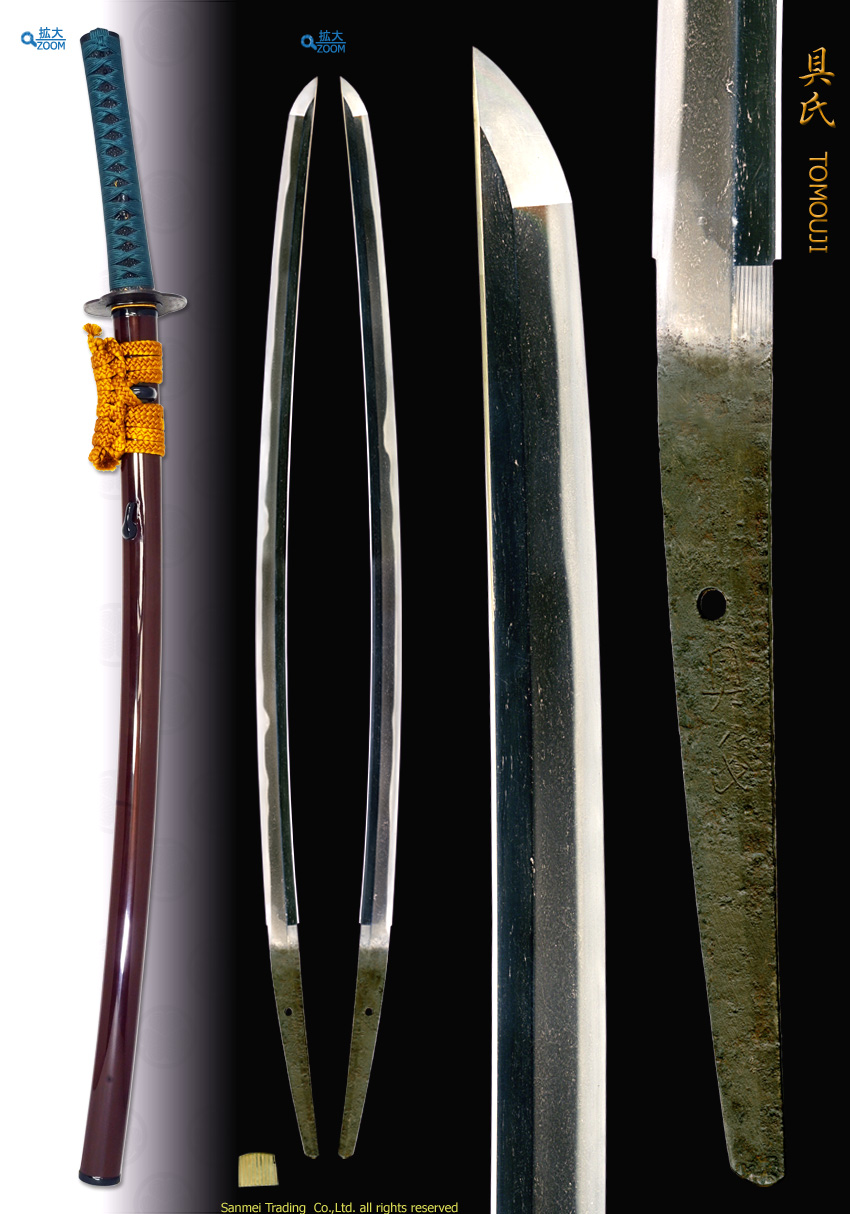with) URUMI-nuri Burgundy lacquered scabbard Tensho-style Koshirae
Length of cutting edge 72.7mm Curvature 1.8cm Width of base 27.7mm Width of Yokote 20.0mm Thickness of base 7.3mm
Forging(Hada): Forging is rather on finer side Itame and conspicuous Masame appears on Shinogi-ji. A bit on coarse side Ji-nie granules attaches on Hiraji that emits diffused reflection of Nie with mottled effect or sparkling profuse Yubashiri like mirages. Darkish lines of Nie so called "CHIKEI" activity wells out from fine steel.
Temper(Hamon): Hamon is Nie-deki, a bit on stronger side hard metal martensite crystals, undulating Notare boundary outline, Gunome and combined Gunome to form Box-shape Hakoba. Some of Gunome splashes into Hiraji surface so called isolatedTobiyaki and Yubashiri. The interior of temper is filled with mist-like crystallize area where is full of rich activitiers Nie and Nioi, vividly bright.
Temper of tip(Boshi): Temper of boshi forms irregular undulating Notare with an indication of brushing Hakikake, medium circle turn back deeply.
Tang(Nakago): The tang is in original "UBU". The heel is un-even U-shaped Ha-agari Kurijiri. One peg hole with checked Higaki Yasurime filemarks. Back ridge of Nakago is flat. The classical inscription signature TOMOUJI 具氏 appears below peg hole along Shinogiji, a bit on Hiraji-side.
Among 5 major schools of Japanese sword centers, Mino-den was late developed school that rised to power in Mino domain (now Gifu pref.)
According to a sword maker directory Nihonto meikan, KANE-MITSU 包光 (in different kanji of KANE 包) who belonged Tegai branch in Yamato school) moved to Seki town, Mino domain during Eiwa era (1375-78) and changed it's name to KANE-MITSU 兼光 in another kanji of KANE 兼. He has been said as the founder of the Seki-sword maker under the patronage of Shinto shrine Kasuga Jinja 春日神社. According to Muromachi-ki Mino-Toko-no Kenkyu, the extant work of KANEMITSU 兼光 with the oldest date of year is a Tanto signed KANEMITSU In the 8th month, the 1st year of Ouei (1394) and had been active throughout Muromachi period in several generations.
The subject maker TOMOUJI 具氏 is given rough age during Tenbun era (1532-) and set his aterier in Seki town, Mino province and the possible relative smith TOMOHIRA 具衡 in the same blood moved to Gifu castle town in later years.
The subject work is full of Samurai majesty spirit during the Warning States of period when major powerful clans such as Oda or Toyotomi in Owari, Tokugawa in Mikawa, Imagawa in Suruga, Takeda in Kai and Hojo in Odawara began rise to power.
This katana was made and supposed to the usage for horse riding battle, deep in curve was designed for fast draw, High-Shinogi-zukuri durable construction was working well for cutting through armor or helmet, Itame forging ware of functional mixture with hard and soft steel was designed for durable construction.
This prominent katana creates a majestic manner of heroic image by powerful Samurai to play for success and has been treasured in generations. Admire for it's invariable shape and the excellent taste of patina in Nakago over the passage of 500 years more. Due to an old polish of decades ago, there are some minor scratches.
with) URUMI-nuri Burgundy lacquered scabbard Tesho-style Koshirae (click HERE for entire Koshirae and HERE for each fitting)
- Fuchi : KIRI crest design, copper ground, Black lacquerd, Gold Makie, unsigned
- Menuki : Ox design, Shakudo ground, katabori carving
- Tsuba : Mokkou-shape, Amida-yasuri design, Irod ground, Uchikaeshi-hammered Mimi, unsigned, attributed to Kacchu-shi
- Tsuka : Black lacquered layskin, NANDO gray indigo-blue silk cord lozenge wrap
Good old polish/Condition scale: excellent - very good (using a scale of mint-excellent-very good-good-fair-poor)
reference data :
Honma Junji/Ishii Masakuni, Nihonto Meikan, Yuzankaku, 1975
Suzuki Takuo/Sugiura Yoshiyuki, Muromachi-ki Mino-Toko-no Kenkyu Ribun-shuppan, 2006
Sugiura Yoshiyuki Mino-to-ko Meikan, Ribun Shuppan, 2008




